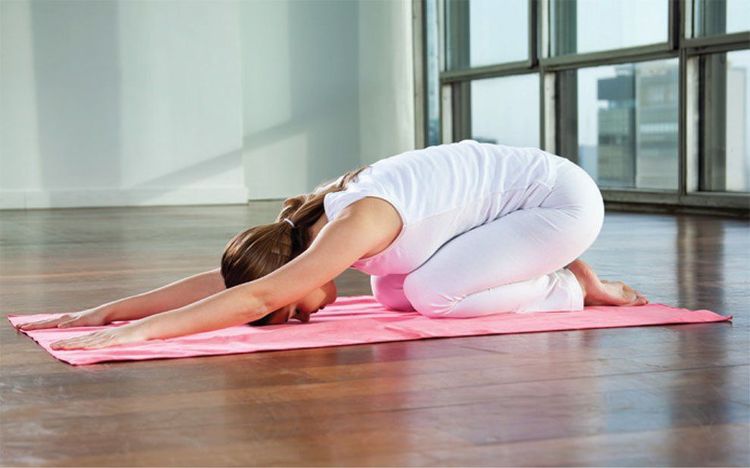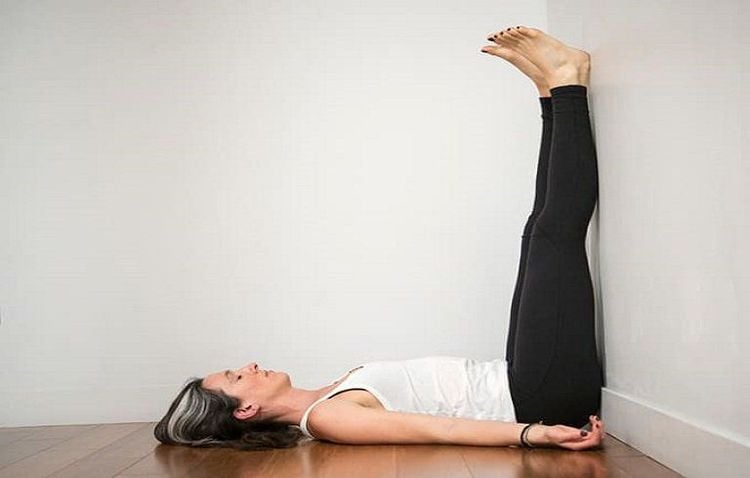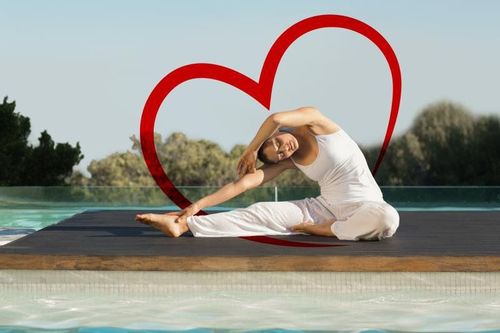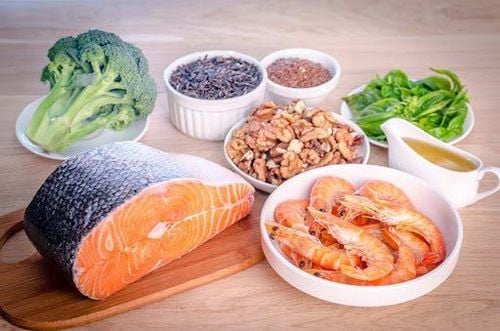This is an automatically translated article.
Many women experience menstrual cramps, which can feel like pain in the abdomen, pelvis (hip area), lower back, and legs. The pain usually peaks the day before your period begins and on the first day of your period. High-intensity exercises such as running may not be suitable. Instead, yoga and breathing exercises can be a good way to help relieve menstrual cramps.1. Does yoga reduce menstrual pain?
Nearly all women experience menstrual symptoms at some point in their lives and up to 15% experience the terrible pain known as dysmenorrhea.
When the uterus contracts during the menstrual cycle, it can cause cramping, pain in the lower abdomen and lower back. This type of muscle pain is the result of the uterine muscles pushing against the surrounding blood vessels and temporarily cutting off oxygen to the muscles. Headaches are another menstrual pain that is often caused by fluctuating levels of estrogen and progesterone. Although modern medicine recommends the use of pain relievers and heat therapy to treat menstrual cramps, there is a different, more holistic approach.
According to Ayureda - a 5,000-year-old system of natural healing, the menstrual cycle is considered as a measure of a woman's overall health.
Menstruation is a time of cleansing and rejuvenation, when cyclical blood flows down and out of the body. While dysmenorrhea is considered common and even normal in Western society, it is not seen as such in the Ayurvedic tradition. Instead, it is seen as an imbalance that can be corrected using holistic healing methods, such as restorative yoga.
The use of yoga for menstrual pain relief is not new. From time immemorial, yoga has been used for healing for thousands of years. However, as modern society becomes more and more concerned with alternative pain management, healthcare providers are also becoming more aware that regular practice and targeted poses can both help reduce pain. menstrual pain both physical and hormonal. Postures that calm the muscles and relax the mind can be helpful in alleviating the impact of menstrual symptoms from cramps and headaches to insomnia.
In particular, Bandhas can help alleviate cramps. Sanskrit for “lock,” “seal,” or “bind,” there are three bandhas that are essentially muscle contractions designed to help you focus on your awareness and breathing, and at the same time Move through the poses with a sense of lightness. Mula bandha is a steady contraction of the perineum (the muscle between your genitals and anus) and aids you in experiencing a soothing sensation. Uddiyana bandha is a contraction of the muscle 4 inches below the navel that allows you to bring your breath into your chest. Finally, Jalandhara bandha, the gesture of lowering the head to the chest. This lock is rarer but is thought to prevent energy from escaping your upper body.
Upavistha Konasana (Wide Angle Forward Bend) is a very good pose for those who suffer from cramps or lower back pain. Sit on the mat with your legs extended in front of you, slightly wider than at a 90-degree angle. Press down through your thighs and inhale and lengthen your spine. Exhale and start walking your hands in front of the mat, keeping your neck relaxed. If you can do this, rest in the pose for 10 to 15 breaths. To add depth to the pose, hook your big toe with your fingers.

Yoga và các bài tập thở có thể là một cách tốt để giúp giảm đau bụng kinh
2. 6 yoga poses to help relieve menstrual pain
For all the movements below, you should use yoga aids, or a few pillows or a soft folded blanket.
2.1. Supta Baddha Konasana (Supta Baddha Konasana) This pose has a wonderful calming effect in yoga practice during menstrual days. This will release pressure on the pelvic area and any weight on the uterus, and help relieve cramping.
Do:
Place a seat at the top of your mat and place your pillow or long pillow in the middle of your low back (with the shorter end of the pad near your sacrum). Bring the soles of your feet together and extend your knees to form a bound angle pose. Feel free to place blocks or pillows under your knees to allow your hips to slowly open up without further strain. Sit up high and slowly lower back down to a support pillow or pillow. Your arms may drop by your side or against blocks or pillows. You close your eyes and your breathing gets deeper, smoother. You should take at least 10 deep and full breaths. To end this pose, pull your knees together with your hands and gently roll the support band to the side. Take a breath or two before returning to your seat. 2.2. Child's Pose (Balasana) This is another great way to release the pelvis and help get rid of muscle tension and cramps. Child's Pose not only helps relieve menstrual cramps, but also helps relieve stress.
Execution:
Begin kneeling on the mat with toes touching and knees wide. Feel free to spread your knees depending on how open your hips are that day. Bring a cushion or knee length back between your legs. If you have another support pillow or pillow available, place it under the first pad for support. Slowly lower your chest and cheeks for support. Inhale again as you wrap your arms around the support or pillow, then exhale completely and close your eyes. Hold for a few minutes. As you breathe in this position, try to focus on releasing any pressure in your abdomen and allowing your vaginal muscles to fully relax. End the pose by bringing your chin toward your neck. steady and drop your hands on the ground. Slowly push back into a sitting position and take a few breaths before continuing. 2.3. Knee Pose (Janu Sirsasana) This is a wonderfully relaxing yoga pose with the added benefit of reducing anxiety and irritability. If your hamstrings are tight, you can place a folded blanket under your hips for support, but don't raise your hips too much.
Note: Avoid this pose if you are bleeding heavily or have diarrhea as this pose targets the digestive and reproductive organs.
Execution:
Sit at the back of the mat, straighten your right leg and bring your left foot inside your right thigh. Place the pad over the long lines of your right shin bone so that the shorter ends are parallel to the face of your mat. Inhale to sit up straight and keep the spine extended as you exhale to your forehead for support. Let your arms rest comfortably on the bar and your head support. You can move the pad to its higher side or add a block or pillow on top of the pad if your forehead doesn't reach the pad. Rest here for a few minutes, allow yourself to rest. Use your breath to help relax your body and release any tension. When you're ready to release, place your hands on the mat and gently reach toward the center and switch sides. 2.4. Upavistha Konasana II This pose helps regulate menstrual flow and stimulates the ovaries to work optimally.
Do it:
Start sitting with your legs wide apart and a pillow or long knee in front of your hips. Place your hands behind your hips and gently press into the floor, inviting your chest to lift and your spine to lengthen. Stay here for a few breaths. Then, inhale and reach your arms over your head and exhale as you gently lean forward until your forehead rests on the pad. Then your arm can also be folded on the pad. You inhale and exhale deeply for a few minutes to allow all your muscles to completely relax. Enhance the feel of your abdomen, pelvis, and vaginal muscles to fully relax.

Việc sử dụng yoga để giảm đau trong thời kỳ kinh nguyệt không phải là mới
2.5. Bridge Pose (Setu Bandha Sarvangasana) Great pose against depression, anxiety and irritability. Allow muscles to be supported and fully relax
Do:
Place your pad or pillow vertically in the center of the mat and sit on one end of the pad. Begin lying down on your support, so that your upper back is not hanging up and your shoulders and head are gently resting on the floor. Straighten your legs and comfortably place an extra pillow under your feet. Arms are relaxed beside you and eyes are closed. Breathe deeply and hold for a few minutes. To end this pose, bring your knees close to your chest and gently roll off the bar. Let your body rest for a few breaths before returning to a sitting position. 2.6. Corpse Pose (Savasana) Using Savasana during your period gives you the opportunity to relax your abdominal and vaginal muscles as well as relieve cramps while providing a feeling of well-being and total revitalization of your mind and body. body.
Execution:
Lie on your back, extend your legs and place your hands, palms facing up, to your sides. Optionally place a pad under your knee for added comfort and recovery. Your breathing becomes rhythmic and relaxed as you raise awareness of your feet. As you exhale, release your feet completely relaxed. Next, inhale and bring your awareness to your calves. Exhale and relax. Continue this pattern over the entire body. Hold the pose for at least 5-10 minutes. Then gently roll into fetal position on the right side to awaken the body and mind. The female body is considered a miraculous temple. It can transform and create other life, so it should be appreciated and loved. As a woman, you have the right to celebrate your body at any stage. And you absolutely deserve time to rest and recover. Take time for yourself and use these poses to connect and grow to love your body more.
Please dial HOTLINE for more information or register for an appointment HERE. Download MyVinmec app to make appointments faster and to manage your bookings easily.
Reference sources: verywellhealth.com, yogiapproved.com, bustling.com, store.lunette.com












